Just repeating your conclusions doesn't make them correct.
You clearly don't understand the difference between an "observation" and a "conclusion".
The difference between the two is important.
"The massive crater in the top of JFK's skull is obvious in the film but maybe you have a different interpretation of that."In the clip below focus on the top of JFK's head before the impact. Focus on the shape of it.
Immediately after the impact the large flap of scalp, described by Jenkins, appears at the side of his head.
As his head moves forward a massive crater is apparent at the top of his head.
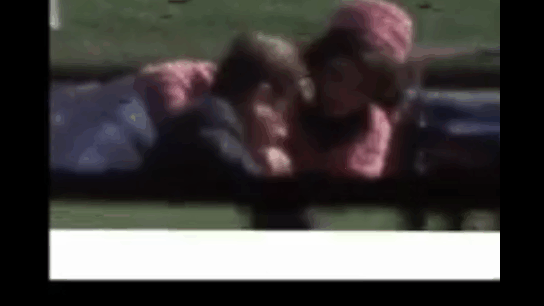
This is an extreme close up of JFK
before the headshot. Note the shape of the top of his head:
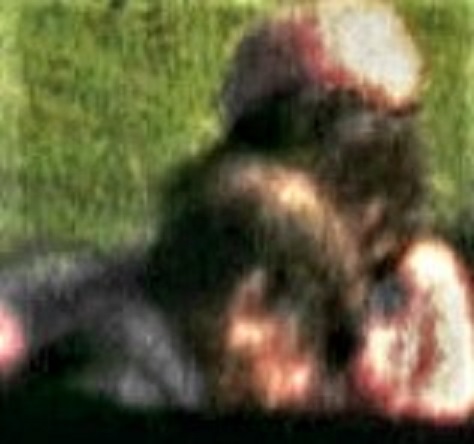
This is an extreme close up of JFK
after the headshot. Note the shape of the top of his head:
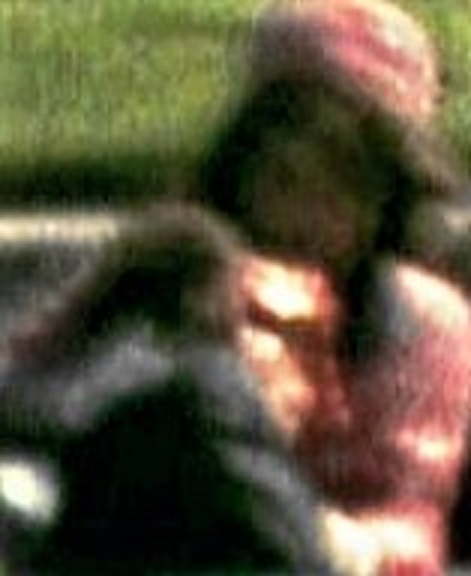
The difference is truly dramatic. There is a massive crater where the top of his head once was.
This is not a conclusion - it's an observation.
"The "jets" flying up from the top of JFKs head are on the film or is there something I'm missing."At the moment of impact, two "jets" of skull/brain matter are fired high in the sky at tremendous speed. It is well known pieces of his skull were found in various locations. These two "jets" are shown clearly on the Z-film and are coming from the top of his head, confirming the pieces of skull were blown upwards and not backwards. The main "jet" is picked out by the red arrow, the lesser "jet" by the yellow arrow:
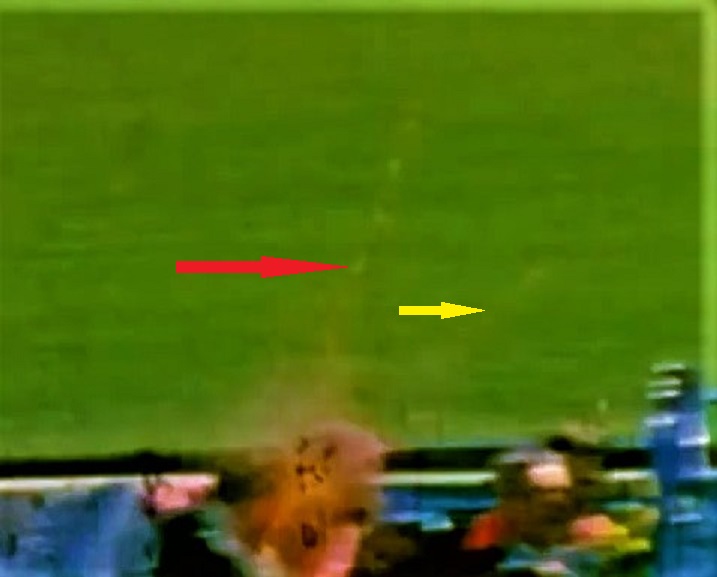
In the frame below, the yellow line represents the line running through the top of his head. This is my own rough estimation and is made to give a general idea of the direction of the "Jets" (marked in red). There can be little doubt these powerful "jets" of skull/brain material are travelling in a straight line from the top of JFK's head. There is nothing even remotely similar exiting the back of his head.
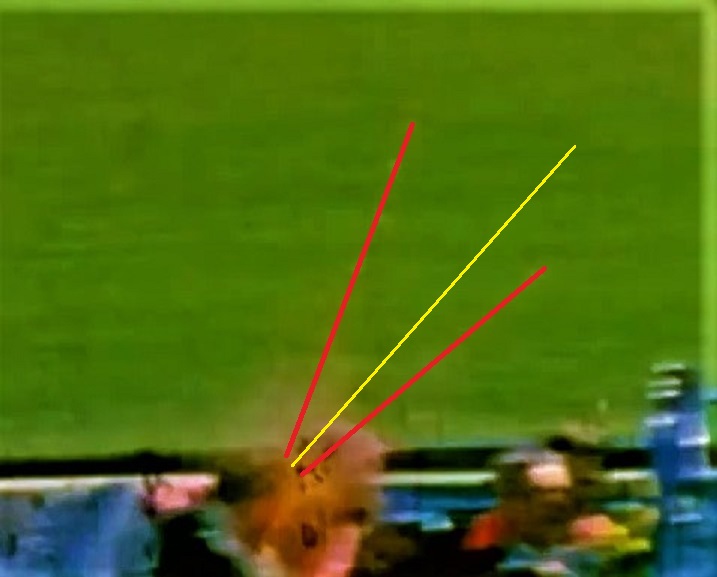
This is not a conclusion - it is an observation.
"The massive red flap of scalp can hardly be missed but maybe you have a better idea than me what it is."In his interview, Jenkins describes the large head wound as scalp and skull opening away from the side of JFK's head. The impression he gives is of a large, hinged flap of scalp that could hang down by the right side of the head. This large flap of scalp is clearly visible in the Z-film hanging down by the side of JFK's head.
In the clip below pay particular attention to the large, pendulous strip of scalp that seems to sway forwards:

This large portion of scalp is picked out by the yellow arrow in the frame below:
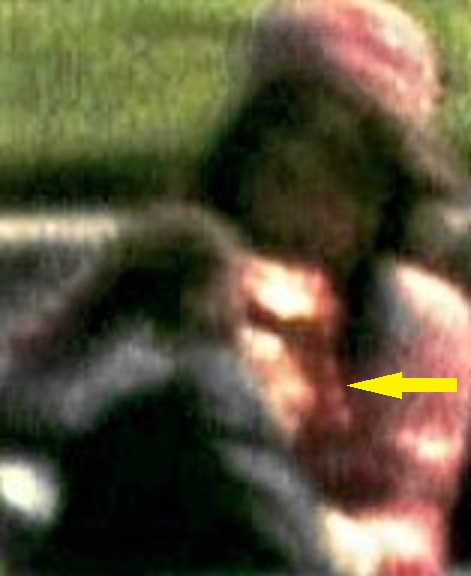
This is not a conclusion - it is an observation.
I did not say that your interpretation is wrong, just that it could be.
But you don't provide any example of how it might be wrong.
You offer no analysis of the evidence and the arguments presented.
You just hide behind snide suggestions that my interpretation
could be wrong or that it isn't persuasive
But what about it isn't persuasive?
What are the weaknesses of the arguments I'm presenting?
How about getting involved rather than just sniping from the sidelines.
Jenkins, who actually saw the wound up close, might have had a far better view than you possibly could have had from a video. You seem to rule out that possibility.
Where do I rule out that possibility or is this just more snide

[this is actually a rhetorical question as the answer is obvious]
Well, let's see. Jenkins clearly shows us in the video, by using a skull, where the actual blast out wound was. That description is the same as that of O'Connor, Robinson, Custer and most of the Parkland ER staff that saw the head wound. Jenkins also explains how the larger wound was, in his opinion, the result of an artificial enlargement. FBI agents Sibert and O'Neill were present when the possibility of "surgery to the head" was being discussed in the autopsy room. They confirm it in their report.
So, it's not really a matter of Jenkins being wrong or not. The question - which you asked yourself but did not answer - is; are all these people wrong? Were Sibert and O'Neill (who Specter declined to call to testify, after an initial conversation) wrong and did they hear something that was never discussed?
Jenkins describes in detail the large injury to JFK's skull. He explains that the majority of the top right side of JFK's skull and scalp came away like a large flap that could be closed up again and that exposed the brain. it is described as s separate injury from the initial "blow-out" hole he describes at the back of the skull.
The large injury he describes is confirmed by the autopsy Gif below:
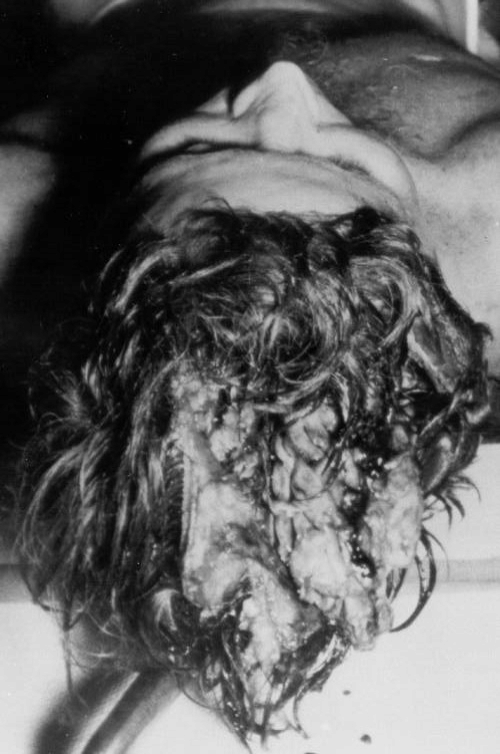
In his interview. Jenkins makes an interesting point:
"When Dr. Humes took the wrappings off the head, there was a secondary wrapping on it that I think was a towel...as he was taking it off this area kind of gapped open [he indicates that the whole top right side of the skull from the saggital suture downwards opened up] but
as soon as we separated it from the towel it went back together."This large flap could be put back in place.
Anyone who saw JFK's head while it was in this condition would have no reason to suspect the full extent of the damage to his head.
The point, however, is that, regardless of his own opinion about it, Jenkins describes a massive injury to the side of JFK's skull that was like a flap that could be opened up.
In the Z-film we see a massive crater appear in the top of JFK's head after impact. This crater represents an absence of skull and scalp in that area. Some of the missing skull has been blown into the air [the "jets"] but a lot of it is still attached to the inside of the scalp [as described by Jenkins] which is hanging down by the side of JFK's head.
Evidence, which authenticity is called into question by the testimony of a substantial number of people, who all saw the actual wound, is hardly persuasive evidence. Neither is your interpretation of the Z film.
Film evidence of the head wound happening is "hardly persuasive"??
Jenkin's detailed description of the head wound is "hardly persuasive"??
The authenticity of what evidence is called into question?